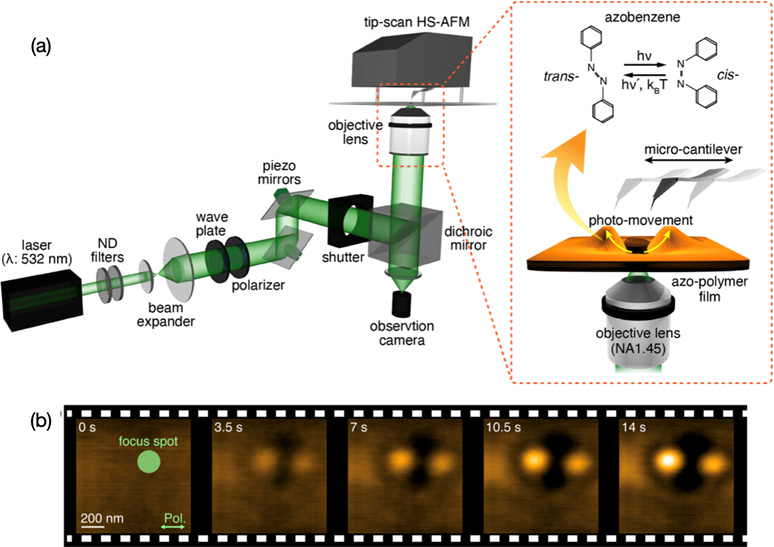
High-speed atomic force microscopy combined with a laser irradiation system for the in-situ real-time observation of azo-polymer deformation process. Credit: Osaka University
Expanding our scientific understanding often comes down to getting as close a look as possible at what is happening. Now researchers from Japan have observed the nanoscale behavior of azo-polymer films while triggering them with laser light.
In a study recently published in Nano Letters the researchers from Osaka University used tip-scan high-speed atomic force microscopy (HS-AFM) combined with an optical microscope to create movies as the polymer films changed.
The Significance of Azo-Polymers
Azo-polymers are photoactive materials, meaning they undergo changes when light is shined on them. Specifically, light changes their chemical structure, which alters the surface of the films. This makes them interesting for applications such as optical data storage and providing light-triggered motion.
Being able to initiate these changes with a focused laser light while capturing images is known as in situ measurement.
Innovations in Measurement Techniques
“It is usual to investigate changes in polymer films by subjecting them to a treatment, such as irradiating with light, and then making measurements or observations afterward. However, this provides limited information,” explains study lead author Keishi Yang. “Using an HS-AFM setup including an inverted optical microscope with a laser, allowed us to trigger changes in azo-polymer films while observing them in real-time with high spatiotemporal resolution.”

(a) Overview of the high-speed atomic force microscopy integrated with the laser irradiation system (b) High-speed atomic force microscope images of the azo-polymer deformation. Credit: The American Chemical Society
The HS-AFM measurements were able to track the dynamic changes in the surfaces of the polymer films in movies with two frames per second. It was also found that the direction of the polarized light used had an influence on the final surface pattern.
Further investigation using the in situ approach is expected to lead to a thorough understanding of the mechanism of light-driven azo-polymer deformation, allowing the potential of these materials to be maximized.
“We have demonstrated our technique for observing polymer film deformation,” says study senior author Takayuki Umakoshi. “However, in doing so, we have shown the potential of combining tip-scan HS-AFM and a laser source for use across materials science and physical chemistry.”
Materials and processes that respond to light are important in a wide range of fields in chemistry and biology, including sensing, imaging, and nanomedicine. The in situ technique provides an opportunity to deepen understanding and maximize potential and are hence expected to be applied to various optical devices.
Reference: “In Situ Real-Time Observation of Photoinduced Nanoscale Azo-Polymer Motions Using High-Speed Atomic Force Microscopy Combined with an Inverted Optical Microscope” by Keishi Yang, Feng-Yueh Chan, Hiroki Watanabe, Shingo Yoshioka, Yasushi Inouye, Takayuki Uchihashi, Hidekazu Ishitobi, Prabhat Verma and Takayuki Umakoshi, 26 February 2024, Nano Letters.
DOI: 10.1021/acs.nanolett.3c04877
The study was funded by the Japan Society for the Promotion of Science and the Ministry of Education, Culture, Sports, Science and Technology.









Be the first to comment on "Scientists Catch Light-Driven Polymers in the Act"